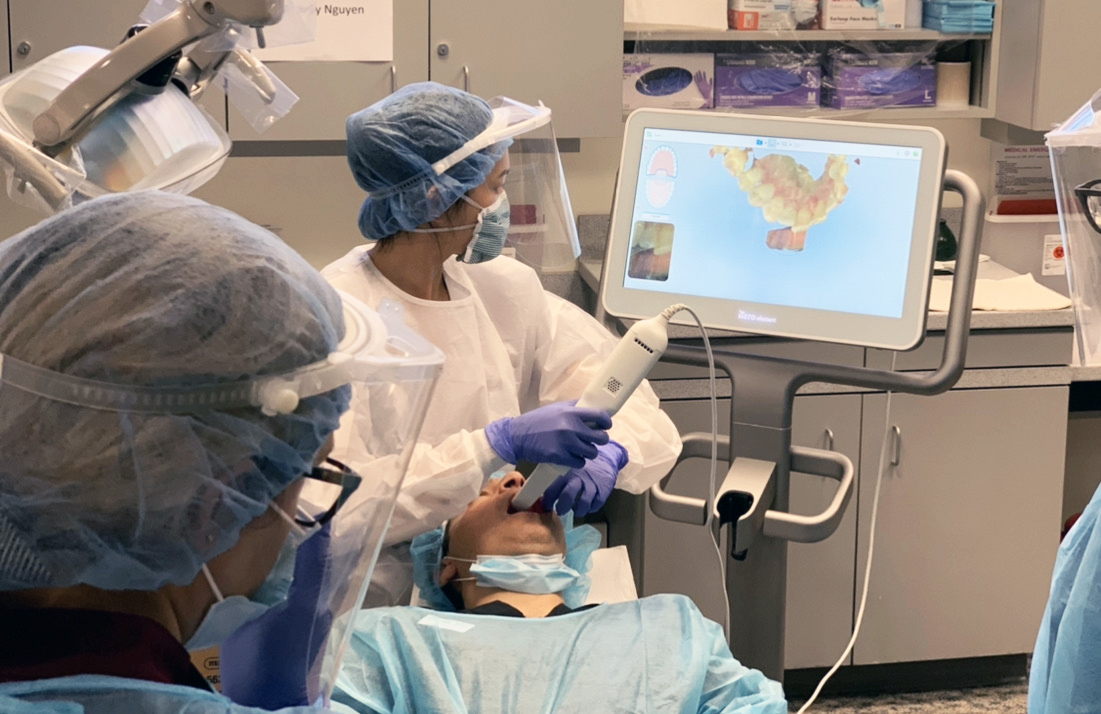Stepping into the Future

Posted
21 Jul 21
Ostrow adds 3-D intraoral scanning training to orthodontics module for DDS and ASPID students.
THROUGHOUT JUNE, THE ADVANCED ORTHODONTICS CLINIC on the Norris Dental Science Center’s third floor was abuzz with activity.
Over the course of five half-day sessions, more than 180 students from the DDS Class of 2024 and the ASPID Class of 2023 visited the clinic for their inaugural 3-D intraoral scanner training — now an integral part of the orthodontics pre-clinical module.
Across six operatories, orthodontics residents guided small groups of DDS and ASPID students in using the technology and assisted them as they scanned their classmates, giving each student their own scan to replace the impression and study casts they’d typically use.
“All of the students were extremely excited to be there and were very engaged,” said Emin Hartunian DDS ’19, ORTHO ’23, one of the orthodontics residents teaching. “These sessions gave me the chance to interact with them by teaching how the scanners work and how it is utilized in the clinic. It was an amazing experience to be able to share my knowledge.”
Deena Fatehi DDS ’24 added, “I went from not knowing what an intraoral scanner was before the training to now contemplating whether or not I should invest in technology like this when I’m a dentist to make my life easier.”
HOW IT WORKS
The intraoral scanner is a wand-like device that is used to take highly-detailed, precise images of the inside of a patient’s mouth.
The scanner sends that information to a computer, which is able to quickly create a 3-D surface model. These scans can then be saved and/or even sent to labs for dental appliances such as retainers, aligner technology, etc.
Such technologies are intended to substitute impressions made using the articulated stone models, which have long been the gold standard of reproducing patients’ hard/soft tissues.
Traditionally, dentists place impression materials into a bulky tray, place it in their patient’s mouth and have them bite down into the soft material, creating a negative mold of their teeth and gums.
After the impression material sets, the trays are removed from the patient’s mouth. The dentist would then pour up stone casts of the patient’s dentition and use it for the fabrication of dental appliances.
The intraoral scanning technology takes some of the work out of the process. There are no bulky trays for patients who might have overactive gag reflexes to choke on.
The data collected from the wand is immediately converted into a precise 3-D model, giving it higher fidelity, and it becomes part of the patient electronic record.
Finally, the scans can be saved electronically, eliminating the need to store physical models and allowing for easy appliance replacement since scans can live “in the cloud” and be accessed at any time.
CUTTING-EDGE EDUCATION
The addition to the pre-clinical curriculum was made possible by the acquisition of four intraoral scanners, thanks to a gift from Ralph Allman ’57, DDS ’62, ORTHO ’66 and his late wife Sigrid Allman.
Allman believes it’s only a matter of time before this technology is widely adopted at practices across the nation.
“Its accuracy has improved immensely year after year to the point where there’s no distortion. It’s very accurate,” he said. “If you make a restoration and you’re using this product, you’re going to come out with a 100 percent guaranteed product.”
Noting his own age, Allman concedes there might be traditionalists who are hesitant to embrace the new technology, but he believes it’s very important to train Ostrow students to use forward-looking technology and techniques.
“Even though I’m old school, I can still learn new things,” he said. “It really excites me to see how good this scanning technology is and to know that it’s only going to better the education of our students.”
LOOKING AHEAD
In his Dean’s Bi-Weekly Message, Dean Avishai Sadan said, “We often say we prepare our students for dentistry, not as it is practiced today, but as it will be practiced in 5, 10, 15 years from now, and I truly believe that this type of intraoral scanning will be commonplace in the coming years, giving our ASPID/DDS students an added benefit as they enter the workforce.”
Mona Albatniji ASPID ’23 agreed that the training would be beneficial for her in her professional journey.
“I think having the training on such a scanner will give us the opportunity to explore even more options to add to our dental offices to improve our performance in the future,” she said. “The training was interesting to many of my classmates, and it allowed us to interact and try the new technology.”
AN UNEXPECTED OUTCOME
More than preparing Ostrow’s students to remain nimble with emerging technology, the new training session may also have the capacity to foster future collaboration between general dentists and orthodontists.
“The scanners really help you see everything much more clearly,” Fatehi said. “It makes it easier for you to see when it would be appropriate to send a patient to an orthodontist.”
Added Albatniji, “If we understand the science behind orthodontics, we can have better collaboration with orthodontists for improved patient’s outcome.”
For both students, the training had an unexpected outcome. “I think it really sparked interest in a lot of people — including myself — in orthodontics,” she said. “I think it opened our eyes to the practice of orthodontics.”